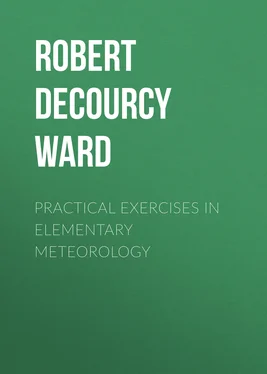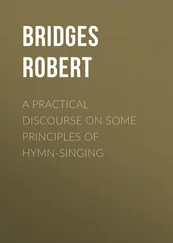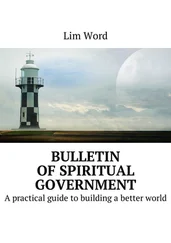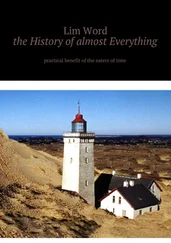Robert DeCourcy Ward - Practical Exercises in Elementary Meteorology
Здесь есть возможность читать онлайн «Robert DeCourcy Ward - Practical Exercises in Elementary Meteorology» — ознакомительный отрывок электронной книги совершенно бесплатно, а после прочтения отрывка купить полную версию. В некоторых случаях можно слушать аудио, скачать через торрент в формате fb2 и присутствует краткое содержание. Жанр: foreign_antique, Физика, foreign_edu, на английском языке. Описание произведения, (предисловие) а так же отзывы посетителей доступны на портале библиотеки ЛибКат.
- Название:Practical Exercises in Elementary Meteorology
- Автор:
- Жанр:
- Год:неизвестен
- ISBN:нет данных
- Рейтинг книги:4 / 5. Голосов: 1
-
Избранное:Добавить в избранное
- Отзывы:
-
Ваша оценка:
- 80
- 1
- 2
- 3
- 4
- 5
Practical Exercises in Elementary Meteorology: краткое содержание, описание и аннотация
Предлагаем к чтению аннотацию, описание, краткое содержание или предисловие (зависит от того, что написал сам автор книги «Practical Exercises in Elementary Meteorology»). Если вы не нашли необходимую информацию о книге — напишите в комментариях, мы постараемся отыскать её.
Practical Exercises in Elementary Meteorology — читать онлайн ознакомительный отрывок
Ниже представлен текст книги, разбитый по страницам. Система сохранения места последней прочитанной страницы, позволяет с удобством читать онлайн бесплатно книгу «Practical Exercises in Elementary Meteorology», без необходимости каждый раз заново искать на чём Вы остановились. Поставьте закладку, и сможете в любой момент перейти на страницу, на которой закончили чтение.
Интервал:
Закладка:
Standard Mercurial Barometer.—A simple form of barometer has been described in Chapter II. The ordinary standard mercurial barometer used by the Weather Bureau (Fig. 10) has the glass tube containing the mercury surrounded by a thin brass covering, through which openings are cut, near the top, on the front and back, exposing to view the glass tube and the top of the mercury column. On one side of this opening there is a strip of metal, graduated to inches and tenths or twentieths, by means of which the height of the barometer is determined. This strip, for barometers used at or near sea level, is about 4 inches long, the variations in pressure under normal conditions not exceeding that amount. In addition to this fixed scale there is a small scale, also graduated, which may be moved up and down the opening in the enclosing brass case by means of a milled head outside and a small rack and pinion inside the brass case. This movable scale, known as the vernier from the name of its inventor, Vernier, is an ingenious device, by means of which more accurate readings of the barometer can be made than is possible with the ordinary fixed scale. A vernier graduated into twenty-five parts enables the observer to make readings accurately to the one-thousandth part of an inch. On the front of the barometer there is a small thermometer, known as the attached thermometer . The bulb of this thermometer, concealed within the metal casing of the barometer, is nearly in contact with the glass tube containing the mercury. The air, upon whose weight the height of the mercury column depends, gains access to the top of the cistern through leather joints, by which the cistern is joined to the glass tube.
Mercurial barometers of the Weather Bureau pattern are best hung in a barometer box, fastened securely against the wall of a room, where there is a good light on the instrument and where the temperature is as constant as possible.
In all accurate work certain corrections have to be applied to barometer readings to make them strictly comparable. These are: (1) correction for altitude ; (2) correction for temperature ; and (3) correction for latitude . The first is necessary because of the fact that the weight of the air decreases upwards, and a barometer reading on a hill or a mountain is not comparable with one at sea level unless the former has been corrected by the addition of the weight of the column of air between the hill or mountain and sea level. The correction for temperature is rendered necessary by the fact that with increasing temperature the mercury in the barometer tube expands more than the metallic scale, because mercury is more sensitive to heat, and unless some allowance is made for this fact, barometer readings made at high temperatures will show somewhat too high a pressure. The readings of the attached thermometer give the temperature of the mercury and are used in making the corrections for temperature. As gravity varies from a maximum value at the poles to a minimum value at the equator, barometer readings made at different latitudes are corrected for latitude , which means that they are reduced to latitude 45°, midway between 0° and 90°. The correction is +0.08″ at the poles and -0.08″ at the equator. Tables for use in correcting barometer readings for altitude and for temperature are given in Chapter XXVI.
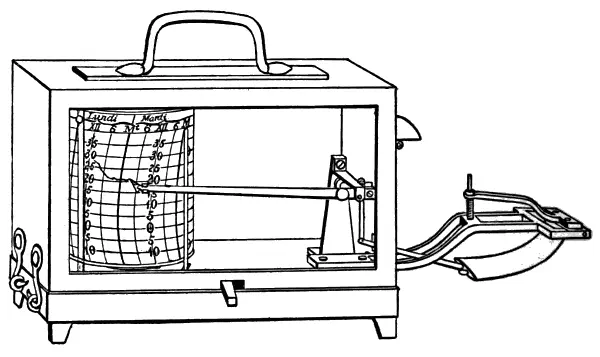
Fig. 11.
Thermograph and Barograph.—Two instruments of much interest are the self-recording thermometer, or thermograph , and the self-recording barometer, or barograph , manufactured by Richard Brothers of Paris. In the thermograph (Fig. 11) there is a brass cylinder around which a sheet of paper is wound, this paper being divided into two-hour intervals of time and into spaces representing differences of 5° or 10° of temperature. The cylinder revolves once in a week, being driven by clock-work contained within it. The thermometer consists of a flat, bent, hollow brass tube containing alcohol, one end of the tube being fastened to the metallic frame seen at the right of the figure, and the other end being free to move. With rising temperature, the liquid in the tube expanding more than the metallic casing, by reason of its greater sensitiveness to heat, tends to straighten the tube, while with falling temperature the elasticity of the tube turns it into a sharper curve. These movements of the free end of the tube are carried through a train of levers and thus magnified. At the end of the last lever is a metallic pen filled with ink, which rests lightly against the paper on the revolving drum. A rise or fall in temperature is thus recorded by a rise or fall of the pen on the record sheet, and a continuous curve of temperature is secured. The pen of the thermograph should be frequently adjusted to make the reading of the instrument accord with that of a standard mercurial thermometer, and care should be taken to have the clock keep good time. These adjustments can readily be made by means of a screw and a regulator, respectively. The thermograph should be exposed in the instrument shelter with the other thermometers. The sheets should be changed, the clock wound, and the pen filled once a week, preferably on Monday, at 8 A.M., or at noon.
The continuous records written by a thermograph are a valuable addition to the fragmentary observations which are the result of eye readings of the ordinary thermometer. From the former any omitted thermometer readings may be supplied. The interest of thermograph records may be seen in the following figure (Fig. 12), in which curves traced under different conditions are reproduced. Curve a illustrates a period of clear warming weather at Nashua, N. H., April 27-30, 1889. Curve b was traced during a spell of cloudy weather at Nashua, accompanying the passage of a West India hurricane, Sept. 13-16, 1889. Curve c illustrates the change from a time of moderate winter weather to a cold spell (Nashua, Feb. 22-25, 1889). Curve d exhibits a steady fall of temperature from the night of one day over the next noon to the following night, during the approach of a winter cold spell (Nashua, Jan. 19-21, 1889). Curve e shows a reverse condition, viz., a continuous rise of temperature through a night from noon to noon (Nashua, Dec. 16-17, 1888). Curve f shows the occurrence of a high temperature at night, caused by warm southerly winds, followed by cold westerly winds (Cambridge, Mass., Nov. 30-Dec. 1, 1890). Curve g illustrates the sudden rise of temperature due to the coming of a hot, dry wind (chinook) at Fort Assiniboine, Mont. (Jan. 19, 1892). A study of such records leads to the discovery of many important facts, which would be completely lost sight of without a continuous record.
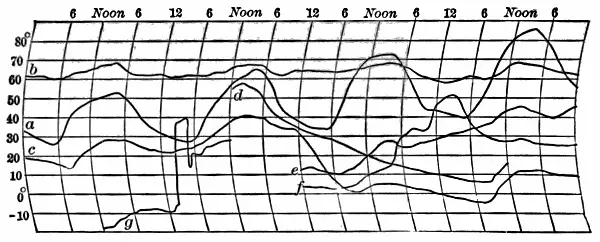
Fig. 12.
The barograph(Fig. 13) is very similar to the thermograph in general appearance. The essential portion of this instrument consists of a series of six or eight hollow shells of corrugated metal screwed one over the other in a vertical column. These shells are exhausted of air, and form, in reality, an aneroid barometer which is six or eight times as sensitive as the ordinary single-chamber aneroid. The springs for distending the shells are inside. The base of the column being fixed, the upper end rises and falls with the variations in pressure. The movements of the shells are magnified by being carried through a series of levers, and, as in the thermograph, the motion is finally given to a pen at the end of the long lever. The compensation for temperature is the same as in the ordinary aneroid. A small quantity of air is left in one of the shells to counteract, by its own expansion at increased temperature, the tendency of the barometer to register too low on account of the weakening of the springs. The barograph may be placed upon a shelf in the schoolroom, where it can remain free from disturbance, and yet where the record may be clearly seen. The general care of the barograph is the same as that of the thermograph. Brief instructions concerning the care and adjustments of these instruments are sent out by the makers with each instrument. Frequent comparison with a mercurial barometer is necessary, the adjustment of the barograph being made by turning a screw, underneath the column of shells, on the lower side of the wooden case.
Читать дальшеИнтервал:
Закладка:
Похожие книги на «Practical Exercises in Elementary Meteorology»
Представляем Вашему вниманию похожие книги на «Practical Exercises in Elementary Meteorology» списком для выбора. Мы отобрали схожую по названию и смыслу литературу в надежде предоставить читателям больше вариантов отыскать новые, интересные, ещё непрочитанные произведения.
Обсуждение, отзывы о книге «Practical Exercises in Elementary Meteorology» и просто собственные мнения читателей. Оставьте ваши комментарии, напишите, что Вы думаете о произведении, его смысле или главных героях. Укажите что конкретно понравилось, а что нет, и почему Вы так считаете.
